简述面向对象三大特性并用示例解释说明?
1,封装:将对象的属性集成在
class person: def __init__(self,name,idnum): self.name=name self.idnum=idnum
2,继承:子类自动拥有父类的的封装,除了非私有之外
class person: def __init__(self,name,idnum): self.name=name self.idnum=idnum class child(person): pass child=child("bigc","1000101") print(child.name)
3,多态:一个变量具有多种形态
class person: def __init__(self,name,idnum): self.name=name self.idnum=idnum class child(person): pass child=child("bigc","1000101") print(child.name) child1=child("bigc1","10001011")
面向中的变量分为哪几种?并用示例说明区别?
实例变量:
class person: def __init__(self,name,idnum):
# 成员变量(实例变量) self.name=name self.idnum=idnum aman=person("hallo kitty","6688")
类变量:
class person: def __init__(self,name,idnum): self.name=name self.idnum=idnum @classmethod def test(cls): p=person()
面向对象中方法有哪几种?并用示例说明区别?
实例方法:在使用的时候用self的方式
类方法:@classmethod传递类名的时候使用
静态方法:@staticmethod不需要传递当前类的对象的时候使用
面试题: 说一说, 静态方法, 类方法和实例方法的区别.
面向对象中的属性有什么?并用示例说明?
属性
用方法来描述我们的属性信息.
注意:
1. @propery 改变一个方法成为属性
2. 这个方法只能有一个参数, self
3. 必须有返回值.
class person: def __init__(self,name,birth,edu): self.name=name self.birth=birth self.edu=self.edu @propery def age(self): return 2018-birth
简述静态方法与类方法的区别
1静态方法相当于函数:里面的对象不需要被传递
2类方法 传递的是类名
面向对象的方法中那个无需传参数?
静态方法:不需要传递类或者对象
面向对象的方法中共有和私有成员在编写和调用的时候有哪些不同?
class haoguanyuan: def __init__(self,name,waimiao,money,fangchan,qingfu): self.name=name self.waimiao=waimiao self.__money=money self.__fangchan=fangchan self.__qingfu=qingfu haoren=haoguanyuan("李逵","和蔼可亲","9999999","8套房","几个新来的实习女大学生") print(haoren.name) print(haoren.waimiao)
》》》李逵
》》》和蔼可亲
》》》print(haoren.money)
AttributeError: 'haoguanyuan' object has no attribute 'money'
公有类,name waimiao ,私有类:money ,qingfu,fangchan,私有类只能内部访问使用,子类不能继承
私有类在属性绑定的时候会需要两个下划线
class haoguanyuan: def __init__(self,name,waimiao,money,fangchan,qingfu): self.name=name self.waimiao=waimiao self.__money=money self.__fangchan=fangchan self.__qingfu=qingfu def buy(self): print("我有%s的钱"%(self.__money)) haoren=haoguanyuan("李逵","和蔼可亲","9999999","8套房","几个新来的实习女大学生") print(haoren.name) print(haoren.waimiao) haoren.buy()
李逵
和蔼可亲
我有9999999的钱
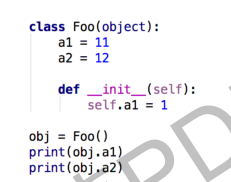
结果:1
12
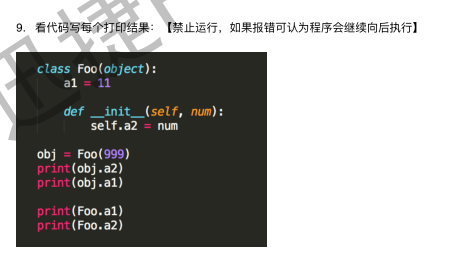
999
11
11
a2报错
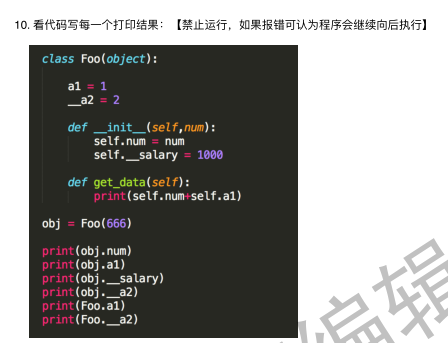
error
1
error 不存在
2
1
2
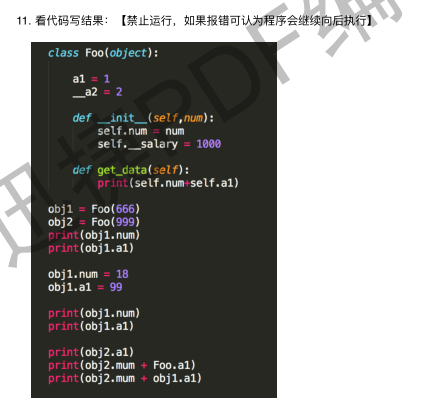
666 1 18 99 1 1000 1017

1 class Foo(object): 2 hobby="大保健" 3 def __init__(self,num): 4 self.num=num 5 self.__salary=1000 6 def f1(self): 7 print(Foo.hobby) 8 @staticmethod 9 def f2(): 10 print(Foo.hobby) 11 @classmethod 12 def f3(cls): 13 print(cls.hobby)

<class '__main__.Foo'>
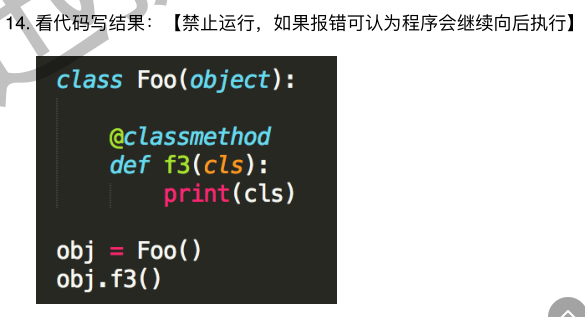
<class '__main__.Foo'>
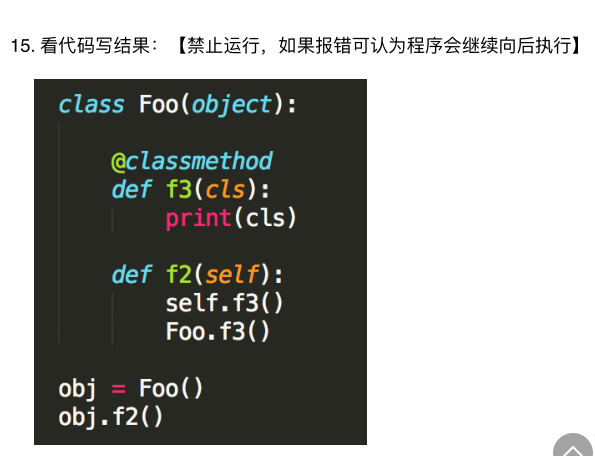
<class "_main_.Foo"> <class "_main_.Foo">

1 foo.f2 2 base.f1 3 <class "_main_.Foo">
请编在写一个私有的静态方法,并通过代码证明私有方法不不能再外部方法但可以在内部访问。
class Person: age = 0 wegiht = 0 __sex = '' def __init__(self): pass @staticmethod def get_stactic_age(): Person.age += 1 # 这里不能用self.age访问 def __add(self): print("这是一个私有方法,只能在类中使用") def get_weight(self): print("这是一个公有方法,可以被类的实例使用") tom = Person() tom.get_weight() #这个可以正常访问 tom.__add() #这个不能正常访问,报AttributeError: 'Person' object has no attribute '__add'异常
现有500W条数据.请使用面向对象的思维来完成这500W条数据的分页
class Page: def __init__(self,lst,pagesize): self.lst=lst self.pagesize=pagesize#测试40行为1页 def start(self): return self.lst[0:self.pagesize] def end(self): return self.lst[-len(self.lst)%self.pagesize:] def index(self,num): return self.lst[(num-1)*(self.pagesize):num*(self.pagesize)] data=["%s测试数据 "%i for i in range(1,5000001)] show=Page(data,40) ye=int(input("请输入你要查询的数据的页数:")) print(show.index(ye))